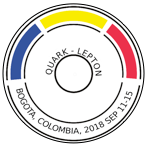Speaker
Description
The experimental measures of flavor mixing angles of quarks and neutrinos, satisfy the empirical relations $\theta_{12}^{q}+\theta_{12}^{l}\approx\pi/4$ and $\theta_{23}^{q}+\theta_{23}^{l}\approx\frac{\pi}{4}$, where $\theta_{12}^{q}$is the mixing angle between the two first generations for the quarks sector and $\theta_{12}^{l}$ is the corresponding for the lepton sector, while $\theta_{23}^{q}$ is the mixing angle between the second and the third generations for the quarks sector and $\theta_{23}^{l}$ is the corresponding for the lepton sector. The previous relations called of complementarity between quarks and leptons (QLC), suggest the existence of a correlation between the mass and mixing matrix of quarks $V_{CKM}$, and the mass and mixing matrix of lepton sector $U_{PMNS}$. Therefore we propose to study the possibility that such correlation between these angles, which determine the proportion of mixing between, the different flavor of neutrinos and quarks, has an origin in the hierarchy of masses of the charged and neutral leptons masses spectrum in analogy with what happens in the context of electroweak standard model, for the hierarchy of masses of the quarks sector. This matrices of mass which are obtained through See-Saw Mechanism (MSS), whether, it is adding a Singlet of Majorana (MSS type I), a Triplet of Majorana (MSS type III) or in our case the simultaneous introduction of a singlet and triplet of Majorana (MSS type I + III hybrid, or MSS-I + III) will be constructed in the context of the two Higgs doblets model type III (M2DH- III) with a selection of particular texture in the Yukawa matrices, in order to obey the restriction of mass of the light neutrinos and besides that, is evidenced a hierarchy in the masses spectrum of these neutrinos, finally to accomplish an exploration over the possible space of free parameters which is consistent with the current experimental data.
